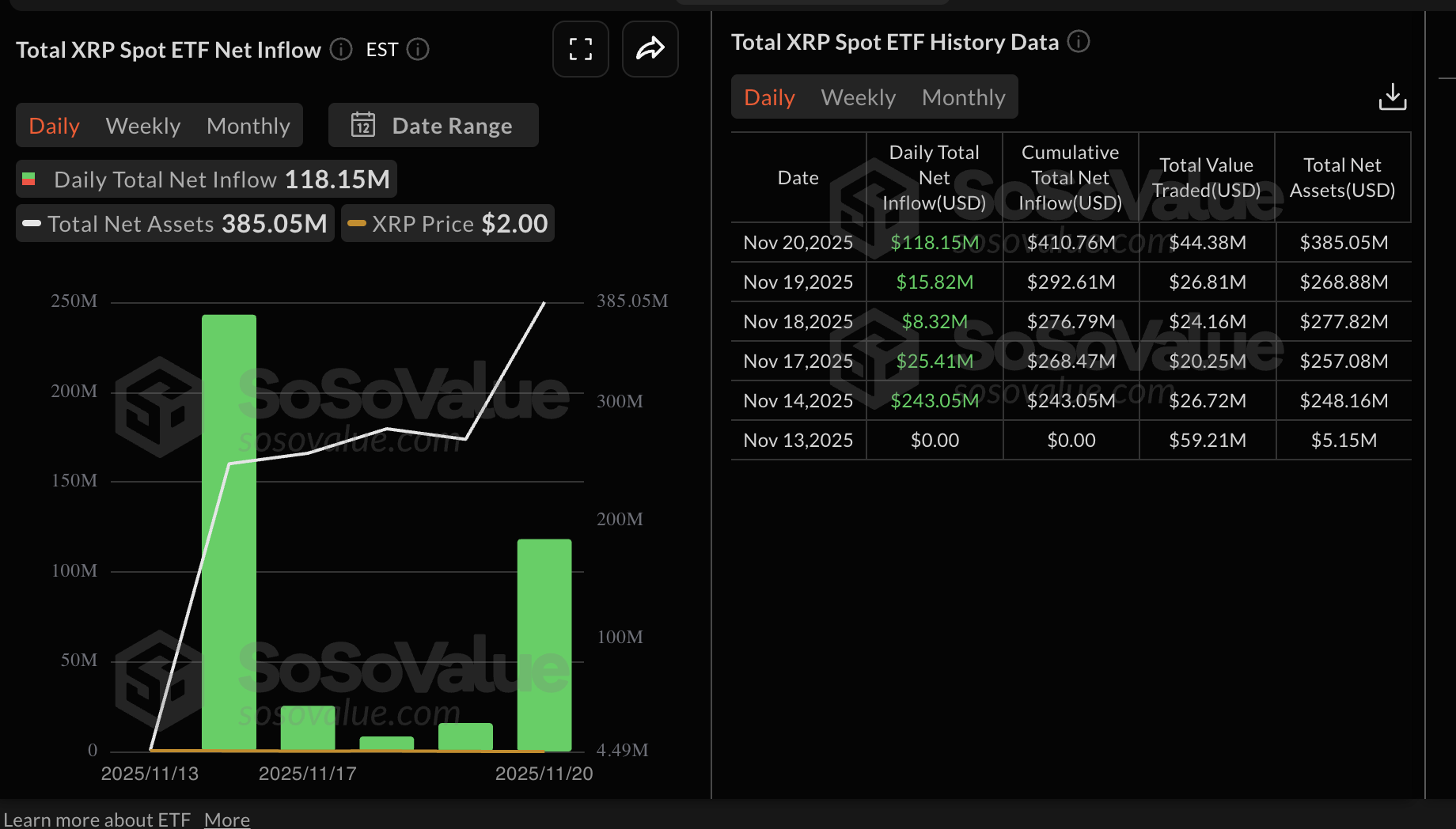Ripple Price Forecast: XRP eyes April lows despite Bitwise ETF launch, steady inflows
- XRP extends its decline below the critical $2.00 level amid heightened volatility, exacerbating risk-off sentiment.
- Bitwise XRP ETF debuts, boosting net inflows to $118 million on Thursday.
- Low retail demand, as evidenced by a weak derivatives market, may cap attempts at recovery.
Ripple (XRP) is extending its down leg below $2.00, trading at $1.87 at the time of writing on Friday. Heightened volatility and macroeconomic uncertainty are supporting the sticky risk-off sentiment in the broader cryptocurrency market.
Since the October 10 flash crash that liquidated over $19 billion in crypto assets in a single day, the cross-border remittance token’s retail demand has not picked up, suggesting a deteriorating market structure.
XRP slides despite ETF inflows
Bitwise XRP ETF started trading on Thursday on the New York Stock Exchange (NYSE), giving United States (US) investors regulated access to the underlying asset (XRP) without directly buying or storing the token themselves. Bitwise’s XRP ETF recorded approximately $105 million in inflow volume on Thursday.
Combined, the Canary Capital XRPC and Bitwise XRP ETFs recorded $118 million in net inflow volume. SoSoValue data shows a cumulative net inflow of $411 million, with net assets of $385 million.

The XRP derivatives market has extended its weakness since mid-October, with futures Open Interest (OI) falling to $3.57 billion on Friday, down from $3.79 billion the previous day.
In comparison, OI, representing the notional value of outstanding futures contracts, stood at $8.36 billion on October 10 and $10.94 billion on July 22. This is a significant drop in retail demand, depriving XRP of the tailwind it needs to sustain a short-term recovery.

Despite the general bearish trend, traders show a desire to increase exposure by buying the deep. The XRP OI-Weighted Funding Rate stance at 0.0072% on Thursday, up from -0.0006% the previous day, indicates that traders are piling into long positions. Demand for XRP derivatives must continue to rise to steady the token’s short-term recovery.

Technical outlook: XRP accelerates downtrend
XRP is extending its down leg toward April lows of $1.61 as investors aggressively reduce exposure, citing high volatility on Friday. The token is positioned significantly below the 50-period, the 100-period, and 200-period Exponential Moving Averages (EMAs), all descending on the 4-hour chart and bearishly aligned. This outlook reinforces a downtrend structure likely to cap attempts at recovery in the short term.
The Moving Average Convergence Divergence (MACD) indicator (blue line) remains below the signal line (red) and under the zero mark, with a widening negative histogram that suggests intensifying downside momentum.
The Relative Strength Index (RSI) stands at 23 (oversold), indicating prolonged selling pressure. If the RSI stabilizes, it could precede a corrective bounce. A contraction in the negative MACD histogram alongside an RSI uptick would hint at stabilization, whereas continued expansion would keep the risk skewed toward the April low at $1.61.

The descending trend line from $3.10 caps recovery, with resistance seen at $2.44, keeping the topside limited unless momentum turns decisively. Any rebound would face headwinds at the falling short-term 50-day EMA ($2.16). Bears would retain control unless price reclaims this level on a closing basis.
Crypto ETF FAQs
An Exchange-Traded Fund (ETF) is an investment vehicle or an index that tracks the price of an underlying asset. ETFs can not only track a single asset, but a group of assets and sectors. For example, a Bitcoin ETF tracks Bitcoin’s price. ETF is a tool used by investors to gain exposure to a certain asset.
Yes. The first Bitcoin futures ETF in the US was approved by the US Securities & Exchange Commission in October 2021. A total of seven Bitcoin futures ETFs have been approved, with more than 20 still waiting for the regulator’s permission. The SEC says that the cryptocurrency industry is new and subject to manipulation, which is why it has been delaying crypto-related futures ETFs for the last few years.
Yes. The SEC approved in January 2024 the listing and trading of several Bitcoin spot Exchange-Traded Funds, opening the door to institutional capital and mainstream investors to trade the main crypto currency. The decision was hailed by the industry as a game changer.
The main advantage of crypto ETFs is the possibility of gaining exposure to a cryptocurrency without ownership, reducing the risk and cost of holding the asset. Other pros are a lower learning curve and higher security for investors since ETFs take charge of securing the underlying asset holdings. As for the main drawbacks, the main one is that as an investor you can’t have direct ownership of the asset, or, as they say in crypto, “not your keys, not your coins.” Other disadvantages are higher costs associated with holding crypto since ETFs charge fees for active management. Finally, even though investing in ETFs reduces the risk of holding an asset, price swings in the underlying cryptocurrency are likely to be reflected in the investment vehicle too.
(The technical analysis of this story was written with the help of an AI tool)

